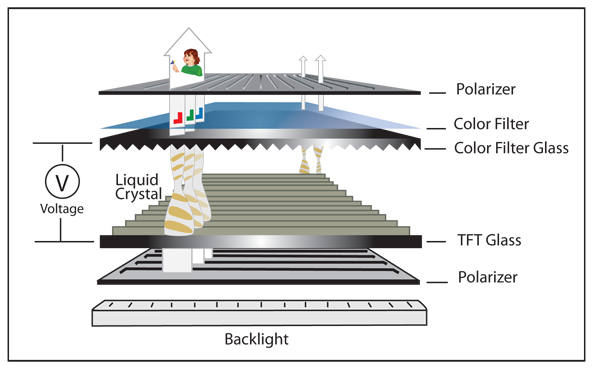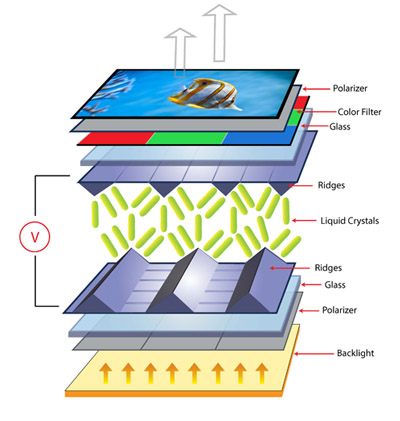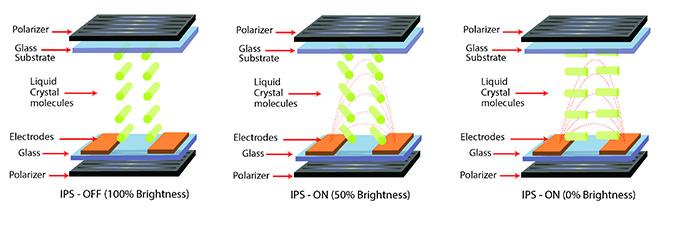TFT (Thin-Film Transistor) Displays are active-matrix LCDs with full RGB color screens. These screens feature bright, vivid colors and have the ability to show fast animations, complex graphics and crisp custom fonts.
TFTs are perfect displays for providing a rich user interface for all types of products. While typically used in consumer devices like personal DVD players and handheld devices, TFTs are also well suited for industrial applications.
Optional touch panels are also available for these types of displays and will transform any standard product to a more engaging experience for the end user.
Newhaven Display currently offers this technology in various sizes ranging from 1.8″ to 7.0″ displays along with the corresponding optional touch panels.
TFTs are Active-Matrix LCDs that have tiny switching transistors and capacitors. These tiny transistors control each pixel on the display and require very little energy to actively change the orientation of the liquid crystal in the display. This allows for faster control of each Red, Green and Blue sub-pixel cell thus producing clear fast-moving color graphics.
The transistors in the TFT are arranged in a matrix on the glass substrate. Each pixel on the display remains off until addressed by applying a charge to the transistor. Unlike conventional Passive-Matrix displays, in order to activate a specific pixel, the corresponding row is turned on and a charge is sent down the proper column. This is where only the capacitor at the designated pixel receives a charge and is held until the next refresh cycle. Essentially, each transistor acts as an active switch. By incorporating an active switch, this limits the number of scan lines and eliminates cross-talk issues.

The pixels of the TFTs are divided into sub-pixels capable of producing various intensities of Red, Green or Blue. The mixture of color and levels of intensity allows for an accurate depiction of any combination of 16.7 million colors.
MVA (Multi-domain Vertical Alignment) displays can offer wide viewing angles, good black depth, fast response times, and good color reproduction and depth. Newhaven Display currently offers this technology as a 5.0″ and 7.0″ TFT with the option of a resistive or capacitive touch panel.
Each pixel within a MVA type TFT consists of three sub-pixels (Red, Green and Blue). Each of these sub-pixels is divided further into two or more sub-pixels, where the liquid crystals are randomly lined up due to the ridged polarized glass.
When a charge is applied to the transistor, the crystals twist. With these crystals being randomly placed, it allows the backlight to shine through in all different directions keeping the intended color saturation retained while giving the display a 150deg. viewing angle.

IPS (In-Plane Switching) displays provide consistent, accurate color from all viewing angles without blur or grayscale inversion. IPS displays show clear images with fast response time, and no halo effect is produced when touched. Newhaven Display currently offers this technology as a high-resolution 4.3″ TFT with built-in controller, with the option of a resistive touch panel.
Each pixel within an IPS type TFT consists of three sub-pixels (Red, Green and Blue). Each sub-pixel has a pair of electrodes to control the twisting of the Liquid Crystals. Unlike TN type TFTs where the electrodes are on opposing plates, the electrodes in an IPS TFT are on only one of the glass plates (i.e. in the sameplane). When voltage is applied to the electrodes, all the Liquid Crystal molecules align in parallel with that plane and allow light to pass through to the polarizers and RGB color filters. In effect, TN displays force the Liquid Crystal molecules perpendicular to the glass which blocks some light from coming out at wide angles, while IPS displays keep the Liquid Crystal molecules in line to allow light through at all angles.

